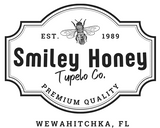Local Honey for Seasonal Allergies: Fact or Fiction?
For millions of allergy sufferers, spring brings not just blooming flowers but also the familiar misery of sneezing, itchy eyes, and congestion. As seasonal allergies become more prevalent and allergy seasons grow longer due to climate change, many people are searching for natural remedies to complement or replace conventional medications. Among these remedies, local honey has gained popularity as a potential solution for alleviating seasonal allergies.
The concept seems intuitive. Consume honey from your local area to build immunity to the pollens that trigger your symptoms. But does science support this sweet remedy, or is it just a sticky myth?
While antihistamines and other medications can effectively control symptoms, they sometimes come with unwanted effects like drowsiness or dry mouth. The appeal of simply adding a spoonful of delicious honey to your daily routine is undeniable. But before you stock up on local honey jars, it's worth examining what research tells us about this remedy's effectiveness, how it might work, and what realistic expectations you should have if you decide to try it.
What are Seasonal Allergies?
Seasonal allergies, also known as allergic rhinitis or hay fever, occur when your immune system overreacts to certain airborne substances. For most sufferers, the primary culprits are:
Tree pollen (typically highest in spring)
Grass pollen (usually peaks in late spring and summer)
Weed pollen (most common in fall, especially ragweed)
Mold spores (can be present year-round but increase during warm, humid periods)
When these allergens enter your body, your immune system mistakenly identifies them as harmful invaders. In response, it produces antibodies that signal your cells to release chemicals like histamine, which cause inflammation and the all-too-familiar allergy symptoms:
Sneezing and a runny nose
Itchy, watery eyes
Congestion and sinus pressure
Scratchy throat
Fatigue
These symptoms can significantly impact quality of life, affecting sleep, productivity, and enjoyment of outdoor activities. It's no wonder that allergy sufferers are constantly searching for effective remedies.
The Theory Behind Local Honey for Allergies
The concept of using local honey to combat allergies is based on a principle similar to immunotherapy, a medically proven allergy treatment. The theory goes something like this:
Bees collect nectar and pollen from plants in your local area
Some of this pollen ends up in the honey
When you consume local honey, you ingest small amounts of these local pollens
Over time, your body becomes desensitized to these allergens, reducing your allergic response
This gradual exposure helps your immune system build tolerance rather than reacting with allergy symptoms
This reasoning mirrors how allergy shots work. However, there's a critical difference between professional immunotherapy and honey consumption, which we'll explore in the next section.
What Science Says About Honey and Allergies?
Despite the widespread belief in honey's allergy-fighting powers, scientific research on the topic is limited and offers mixed results.
A small study in Malaysia found that honey consumption, along with antihistamines, was associated with improvement in allergy symptoms compared to using antihistamines alone. However, the participants were taking very high daily doses of honey after eight weeks, making it difficult to determine whether the improvements were due to the honey alone.
In contrast, a 2002 Connecticut study divided allergy sufferers into three groups receiving either local honey, commercially processed honey, or honey-flavored corn syrup (placebo). After monitoring their symptoms, researchers found no significant difference between the groups, suggesting that honey had no measurable effect on allergies.
Several factors may explain why local honey might not work as expected for allergies:
Pollen Type Mismatch
The most critical issue is that honey primarily contains flower pollen collected by bees, while most seasonal allergies are triggered by windborne pollens from trees, grasses, and weeds. As allergist Dr. Zachary Rubin explains, "Bees collect pollen from flowers, and flower pollen is not what typically causes seasonal allergies." Flowers produce heavier, stickier pollen designed to be carried by insects, not by wind.
Insufficient Concentration
The amount of allergenic pollen in honey may be too small to effectively desensitize the immune system. Professional immunotherapy uses precisely measured amounts of allergens that gradually increase over time.
Processing Effects
Commercial honey processing can remove most pollen, potentially limiting any beneficial effects. Even raw honey may not contain consistent or significant amounts of the specific pollens causing your allergies.
Potential Benefits of Honey Beyond Allergies
While the evidence for honey as an allergy treatment is inconclusive, honey does offer other potential health benefits:
Cough suppression : Honey is effective for soothing coughs, particularly in children over one year of age. Its thick consistency creates a protective coating in the throat that can reduce irritation.
Antimicrobial properties : Some types of honey, particularly Manuka honey, have natural antibacterial qualities that have been used in traditional medicine for treating wounds and infections.
Antioxidant content : Honey contains various plant compounds that act as antioxidants, potentially offering protective effects against certain diseases.
Soothing properties : Many people find that honey provides temporary relief for a sore throat, making it a popular home remedy during cold and flu season.
These benefits make honey a worthwhile addition to your diet, even if its effects on allergies remain unproven.
How to Use Local Honey? (If You Want to Try)
If you'd like to try local honey for allergies despite the limited scientific support, here are some guidelines:
Choose the right honey : Look for raw, unfiltered honey from hives within about 50 miles of your home. This increases the chances that it contains pollen from your local environment. Farmers' markets and local beekeepers are often the best sources.
Start early : If you're hoping for allergy relief, begin consuming local honey several weeks or months before your typical allergy season starts. This gives your body time to potentially build tolerance.
Consistency matters : Take small amounts daily rather than occasional larger doses. A common recommendation is 1-2 teaspoons per day.
Be patient : Any potential benefits would likely develop gradually over time, not immediately. Don't expect instant relief from acute symptoms.
Use it as a complement : Consider honey as a supplement to proven allergy management strategies, not as your only approach.
Safety note : Never give honey to infants under 12 months old due to the risk of infant botulism, a rare but serious form of food poisoning.
Final Call
The idea of treating allergies with local honey has intuitive appeal and some anecdotal support, but scientific evidence for its effectiveness remains limited and mixed. That said, honey offers other health benefits and has minimal risk for most adults. If you enjoy the taste and want to try it as a complementary approach to allergy management, there's little downside. Just maintain realistic expectations and don't rely on honey as your sole strategy for managing significant allergy symptoms.
At Smiley Honey, our raw, unfiltered honey preserves all the enzymes, pollen, and beneficial compounds just as the bees intended. Nothing added, nothing removed, just pure liquid gold the way nature intended!
For those who crave nature's most powerful antioxidant boost, our Wildflower honey delivers an intoxicating complexity that changes with each season, capturing the essence of whatever blooms our bees are visiting.
Elevate your everyday with Smiley Honey today. Order now and transform your morning ritual into something extraordinary!
Frequentlty Asked Questions
How much local honey should I take for allergies?
If trying honey for allergies, most recommendations suggest 1-2 teaspoons daily, starting several weeks before allergy season. Consistency is key, as any potential benefits would come from regular exposure. Remember that scientific evidence for honey's effectiveness against allergies remains limited.
Is raw honey better than regular honey for allergies?
Raw honey contains more pollen and enzymes than highly processed honey, so it's the preferred choice if trying honey for allergies. However, even raw honey primarily contains flower pollen rather than the windborne pollen that typically causes seasonal allergies, which limits its potential effectiveness.
How long does it take for local honey to help with allergies?
Any potential benefits from honey would likely develop gradually. Some proponents suggest starting consumption at least 2-3 months before allergy season. However, scientific evidence for honey's effectiveness against allergies is inconclusive, so timeframes for results vary widely in anecdotal reports.
Can children use honey for allergy relief?
Children over one year of age can safely consume honey in age-appropriate amounts. However, never give honey to infants under 12 months due to the risk of infant botulism. As with adults, scientific evidence for honey's effectiveness against allergies in children is limited.


